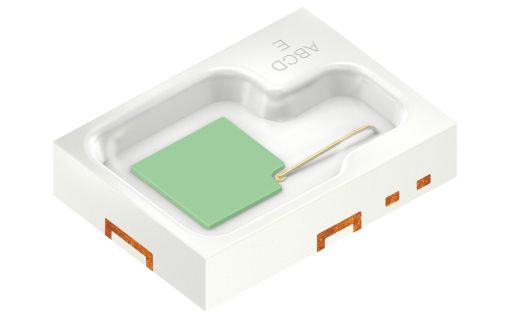Checking food with a smartphone thanks to a broadband infrared LED from Osram
The compact Synios SFH 4776 is the latest addition to the product portfolio for spectroscopy applications
Consumers will soon be able to use their smartphones to check how fresh supermarket food is, measure the calories in canteen meals and verify whether the tablet in their hand really is a painkiller. All thanks to the development of broadband infrared LEDs (IREDs) that emit in a wide wavelength range. When Osram Opto Semiconductors presented the Oslon Black Flat SFH 4735 at the end of 2016 it opened up the consumer sector to this technology. To date, Osram is the only one to offer such IREDs. With the tiny SFH 4776 spectroscopy applications can be integrated into smartphones.
Near-infrared spectroscopy enables such things as the water, fat, sugar and protein content of food to be measured. This technology uses the characteristic absorption behavior of certain molecular compounds. If a defined light spectrum is directed at a sample it is possible to determine the presence and quantity of certain ingredients from the wavelength distribution of the reflected light. An IRED, such as the SFH 4776, acts as a compact light source for the spectrometer.
The Synios package of the SFH 4776 is only 0.6 mm high and has a particularly space-saving footprint of 2.75 mm x 2.0 mm, making it ideal for use in smartphones. With the development of SFH 4776 Osram Opto Semiconductors is therefore addressing the latest trends such as technology-based fitness monitoring and the gradual spread of electronic aids in the health sector.
Like the SFH 4735, SFH 4776 is based on a highly efficient, blue-emitting ThinGaN chip in UX:3 technology. A phosphor converter specially developed for spectroscopy converts blue light into infrared light with a broad wavelength range of 650 nm to 1050 nm. By making improvements to the phosphor material, developers at Osram Opto Semiconductors have succeeded in increasing the intensity of the light by an impressive 60 percent compared with the predecessor component. For the customer this means an improved signal-to-noise ratio and therefore simpler analysis of food and medicines.


ABOUT OSRAM
OSRAM, based in Munich, is a leading global high-tech company with a history dating back more than 110 years. Primarily focused on semiconductor-based technologies, our products are used in highly diverse applications ranging from virtual reality to autonomous driving and from smart phones to smart and connected lighting solutions in buildings and cities. OSRAM uses the endless possibilities of light to improve the quality of life for individuals and communities. OSRAM’s innovations enable people all over the world not only to see better, but also to communicate, travel, work and live better. OSRAM has approximately 26,400 employees worldwide as of end of fiscal 2017 (September 30) and generated revenue of more than €4.1 billion. The company is listed on the stock exchanges in Frankfurt and Munich (ISIN: DE000LED4000; WKN: LED400; trading symbol: OSR). Additional information can be found at www.osram.com.